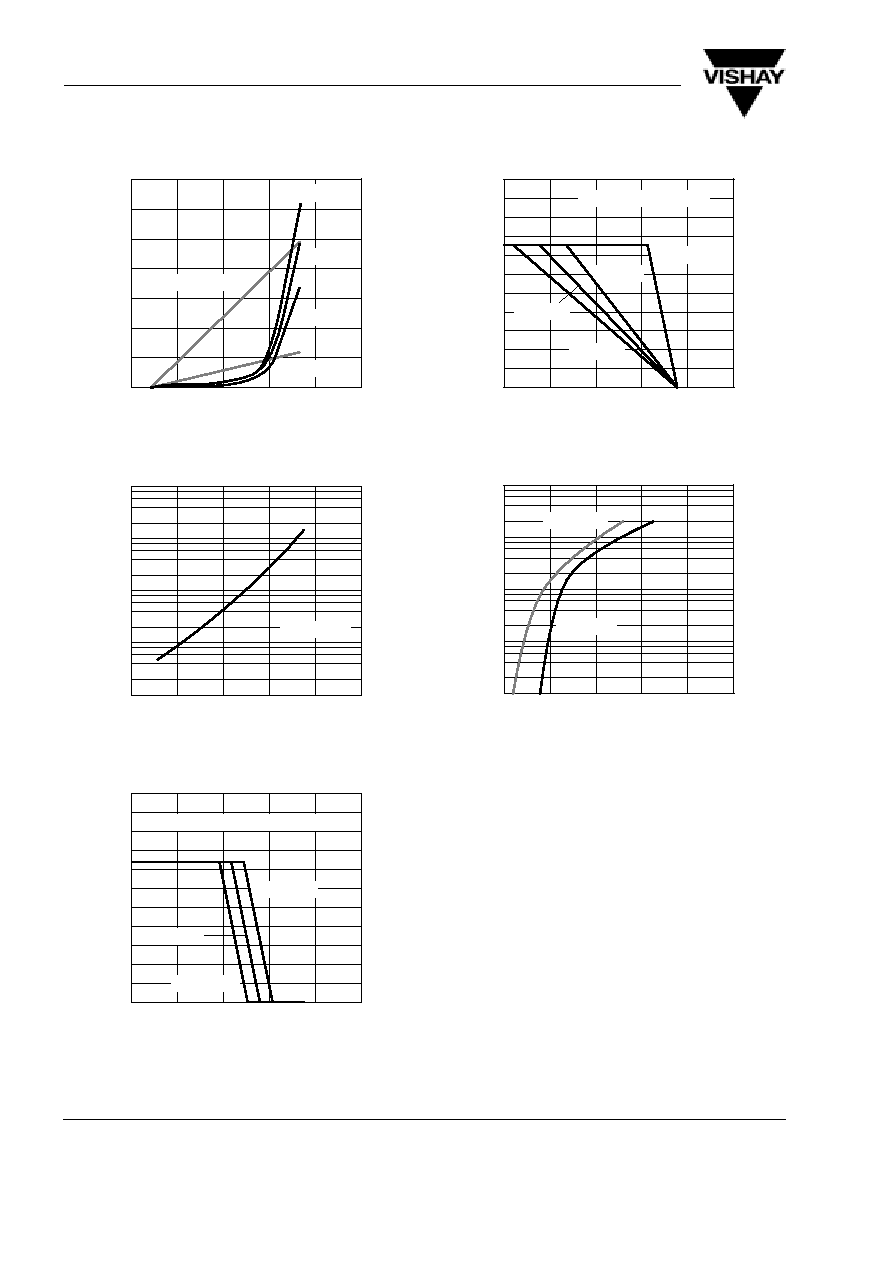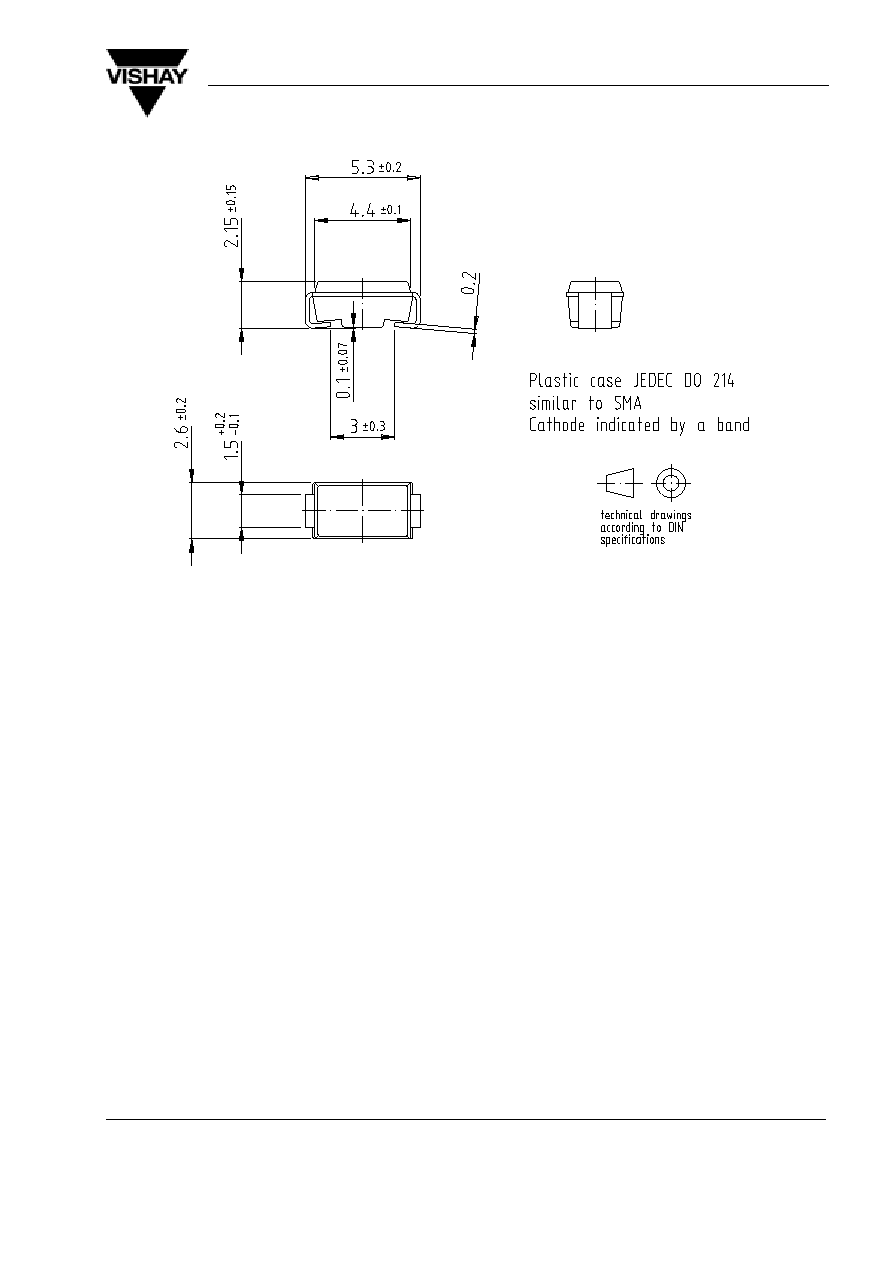
BYS10
Vishay Telefunken
www.vishay.de
∑
FaxBack +1-408-970-5600
Rev. 2, 24-Jun-98
1 (4)
Document Number 86013
Schottky Barrier Rectifier
Features
D
High efficiency
D
Low power losses
D
Very low switching losses
D
Low reverse current
D
High surge capability
Applications
Polarity protection
Low voltage, high frequency rectifiers
15 811
Absolute Maximum Ratings
T
j
= 25
_
C
Parameter
Test Conditions
Type
Symbol
Value
Unit
Reverse voltage
BYS10≠25
V
R
25
V
g
=Repetitive peak reverse voltage
BYS10≠35
R
=V
RRM
35
V
BYS10≠45
45
V
Peak forward surge current
t
p
=10ms, half sinewave
I
FSM
30
A
Average forward current
I
FAV
1.5
A
Junction and storage
temperature range
T
j
=T
stg
≠55...+150
∞
C
Maximum Thermal Resistance
T
j
= 25
_
C
Parameter
Test Conditions
Symbol
Value
Unit
Junction lead
T
L
=constant
R
thJL
25
K/W
Junction ambient
mounted on epoxy≠glass hard tissue
R
thJA
150
K/W
mounted on epoxy≠glass hard tissue, 50mm
2
35
m
m Cu
R
thJA
125
K/W
mounted on Al≠oxid≠ceramic (Al
2
O
3
), 50mm
2
35
m
m Cu
R
thJA
100
K/W
Electrical Characteristics
T
j
= 25
_
C
Parameter
Test Conditions
Type
Symbol
Min
Typ
Max
Unit
Forward voltage
I
F
=1A
V
F
500
mV
Reverse current
V
R
=V
RRM
I
R
500
m
A
V
R
=V
RRM
, T
j
=100
∞
C
I
R
10
mA

BYS10
Vishay Telefunken
www.vishay.de
∑
FaxBack +1-408-970-5600
Rev. 2, 24-Jun-98
2 (4)
Document Number 86013
Characteristics (T
j
= 25
_
C unless otherwise specified)
0
40
80
120
160
0
1
2
3
4
7
200
95 9710
P
≠ Maximum Reverse Power Dissipation (
W
)
R
T
j
≠ Junction Temperature (
∞
C )
5
6
BYS10-25
BYS10-35
BYS10-45
R
thJA
=100K/W
R
thJA
=25K/W
Figure 1. Max. Reverse Power Dissipation vs.
Junction Temperature
0
40
80
120
160
0.1
1
10
100
1000
200
95 9711
I ≠ Reverse Current ( mA
)
R
T
j
≠ Junction Temperature (
∞
C )
V
R
= V
R RM
Figure 2. Max. Reverse Current vs.
Junction Temperature
0
0
0.4
0.8
1.2
1.6
2.0
I ≠
A
verage
Forward
Current
(
A
)
FA
V
T
amb
≠ Ambient Temperature (
∞
C )
95 9712
40
80
120
160
200
V
R
= V
R RM
, Half Sinewave, R
thJA
=25K/W
BYS10-25
BYS10-35
BYS10-45
Figure 3. Max. Average Forward Current vs.
Ambient Temperature
0
0
0.4
0.8
1.2
1.6
2.0
I ≠
A
verage
Forward
Current
(
A
)
FA
V
T
amb
≠ Ambient Temperature (
∞
C )
95 9713
40
80
120
160
200
V
R
= 0 V, Half Sinewave
100K/W
125K/W
150K/W
R
thJA
=25K/W
Figure 4. Max. Average Forward Current vs.
Ambient Temperature
0
0.4
0.8
1.2
1.6
0.01
0.1
1
10
100
2.0
95 9714
I ≠ Forward Current (
A
)
F
V
F
≠ Forward Voltage ( V )
T
j
= 25
∞
C
T
j
= 150
∞
C
Figure 5. Max. Forward Current vs. Forward Voltage

BYS10
Vishay Telefunken
www.vishay.de
∑
FaxBack +1-408-970-5600
Rev. 2, 24-Jun-98
4 (4)
Document Number 86013
Ozone Depleting Substances Policy Statement
It is the policy of Vishay Semiconductor GmbH to
1. Meet all present and future national and international statutory requirements.
2. Regularly and continuously improve the performance of our products, processes, distribution and operating
systems
with respect to their impact on the health and safety of our employees and the public, as well as their impact on
the environment.
It is particular concern to control or eliminate releases of those substances into the atmosphere which are known as
ozone depleting substances ( ODSs ).
The Montreal Protocol ( 1987 ) and its London Amendments ( 1990 ) intend to severely restrict the use of ODSs and
forbid their use within the next ten years. Various national and international initiatives are pressing for an earlier ban
on these substances.
Vishay Semiconductor GmbH has been able to use its policy of continuous improvements to eliminate the use of
ODSs listed in the following documents.
1. Annex A, B and list of transitional substances of the Montreal Protocol and the London Amendments respectively
2 . Class I and II ozone depleting substances in the Clean Air Act Amendments of 1990 by the Environmental
Protection Agency ( EPA ) in the USA
3. Council Decision 88/540/EEC and 91/690/EEC Annex A, B and C ( transitional substances ) respectively.
Vishay Semiconductor GmbH can certify that our semiconductors are not manufactured with ozone depleting
substances and do not contain such substances.
We reserve the right to make changes to improve technical design and may do so without further notice.
Parameters can vary in different applications. All operating parameters must be validated for each customer application
by the customer. Should the buyer use Vishay-Telefunken products for any unintended or unauthorized application, the
buyer shall indemnify Vishay-Telefunken against all claims, costs, damages, and expenses, arising out of, directly or
indirectly, any claim of personal damage, injury or death associated with such unintended or unauthorized use.
Vishay Semiconductor GmbH, P.O.B. 3535, D-74025 Heilbronn, Germany
Telephone: 49 ( 0 ) 7131 67 2831, Fax number: 49 ( 0 ) 7131 67 2423



